Design Thinking in Educational Advances
VerifiedAdded on 2022/11/28
|11
|2544
|400
AI Summary
This report discusses the applications of design thinking in educational advancements and explores various design thinking tools used in the education sector. It emphasizes the importance of design thinking in transforming the structure of educational institutions and promoting human potential and talents.
Contribute Materials
Your contribution can guide someone’s learning journey. Share your
documents today.
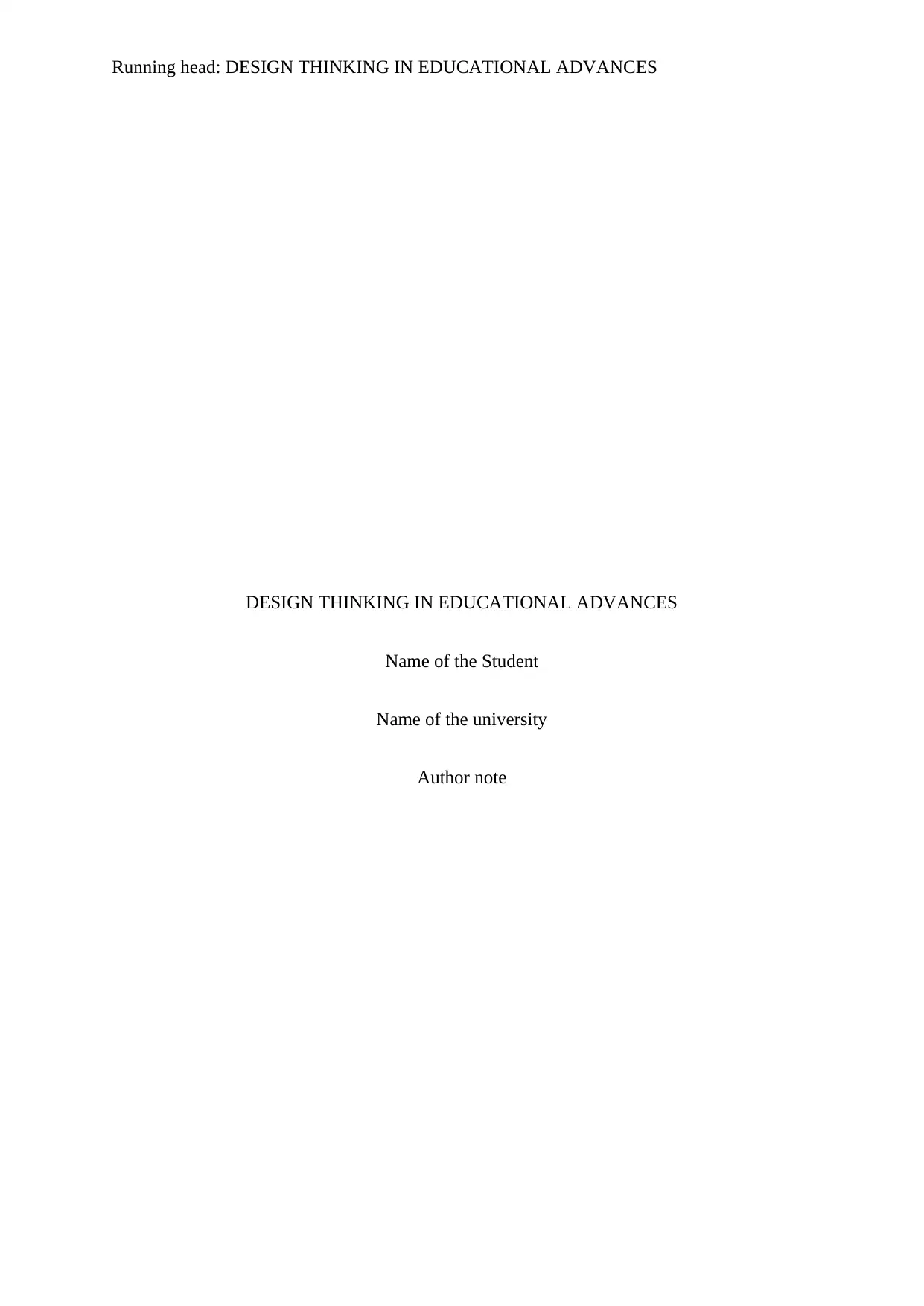
Running head: DESIGN THINKING IN EDUCATIONAL ADVANCES
DESIGN THINKING IN EDUCATIONAL ADVANCES
Name of the Student
Name of the university
Author note
DESIGN THINKING IN EDUCATIONAL ADVANCES
Name of the Student
Name of the university
Author note
Secure Best Marks with AI Grader
Need help grading? Try our AI Grader for instant feedback on your assignments.
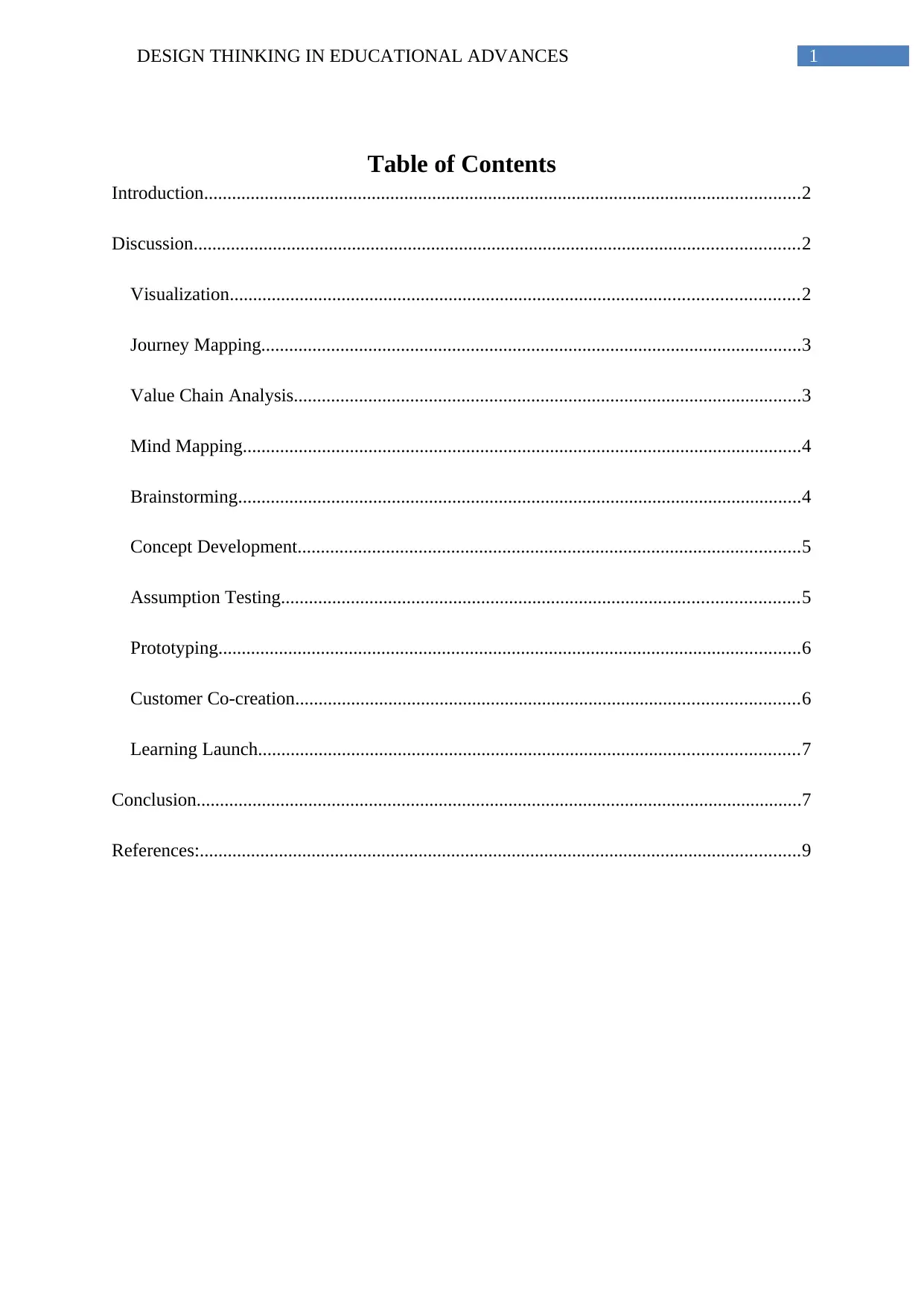
1DESIGN THINKING IN EDUCATIONAL ADVANCES
Table of Contents
Introduction................................................................................................................................2
Discussion..................................................................................................................................2
Visualization..........................................................................................................................2
Journey Mapping....................................................................................................................3
Value Chain Analysis.............................................................................................................3
Mind Mapping........................................................................................................................4
Brainstorming.........................................................................................................................4
Concept Development............................................................................................................5
Assumption Testing...............................................................................................................5
Prototyping.............................................................................................................................6
Customer Co-creation............................................................................................................6
Learning Launch....................................................................................................................7
Conclusion..................................................................................................................................7
References:.................................................................................................................................9
Table of Contents
Introduction................................................................................................................................2
Discussion..................................................................................................................................2
Visualization..........................................................................................................................2
Journey Mapping....................................................................................................................3
Value Chain Analysis.............................................................................................................3
Mind Mapping........................................................................................................................4
Brainstorming.........................................................................................................................4
Concept Development............................................................................................................5
Assumption Testing...............................................................................................................5
Prototyping.............................................................................................................................6
Customer Co-creation............................................................................................................6
Learning Launch....................................................................................................................7
Conclusion..................................................................................................................................7
References:.................................................................................................................................9
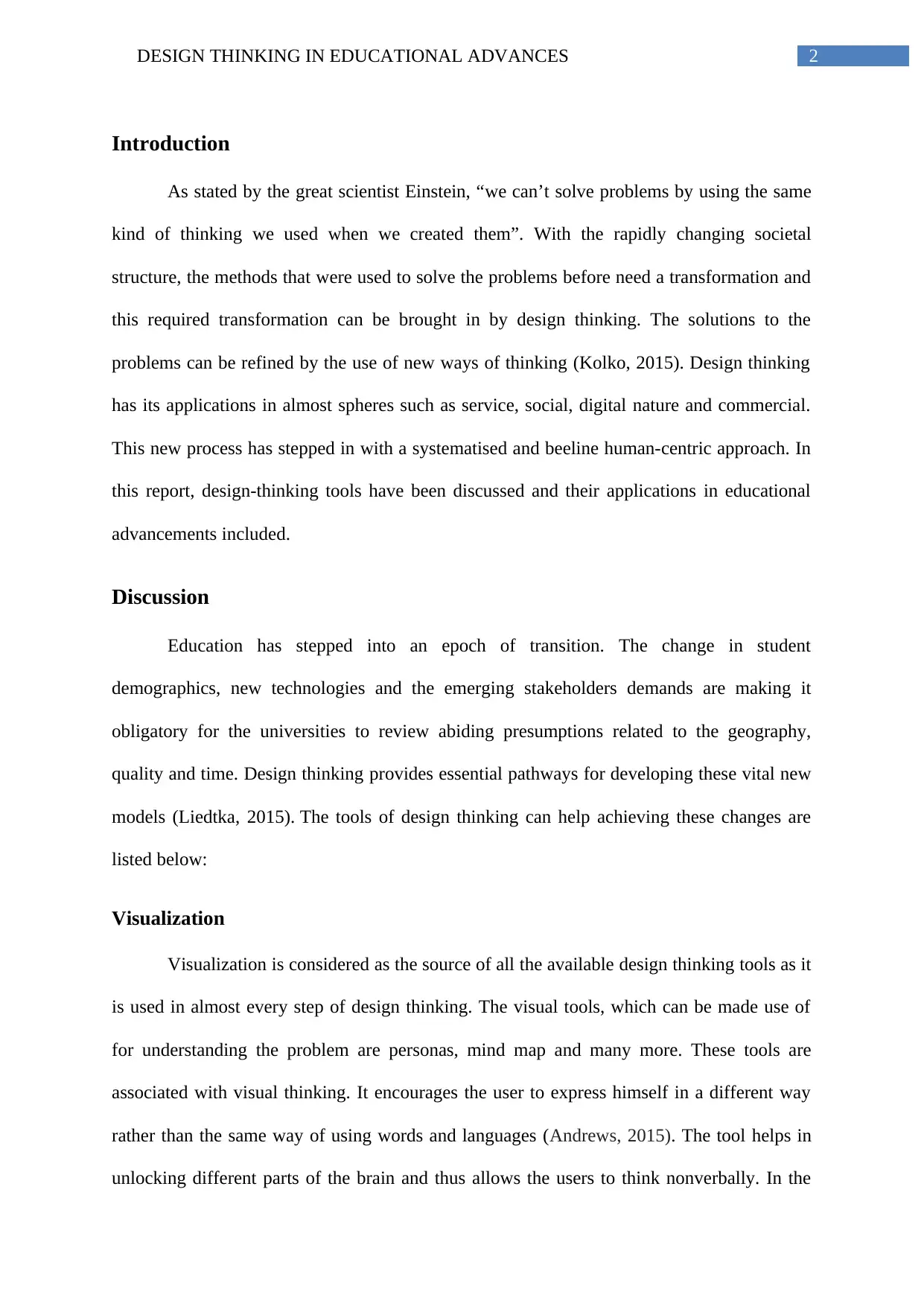
2DESIGN THINKING IN EDUCATIONAL ADVANCES
Introduction
As stated by the great scientist Einstein, “we can’t solve problems by using the same
kind of thinking we used when we created them”. With the rapidly changing societal
structure, the methods that were used to solve the problems before need a transformation and
this required transformation can be brought in by design thinking. The solutions to the
problems can be refined by the use of new ways of thinking (Kolko, 2015). Design thinking
has its applications in almost spheres such as service, social, digital nature and commercial.
This new process has stepped in with a systematised and beeline human-centric approach. In
this report, design-thinking tools have been discussed and their applications in educational
advancements included.
Discussion
Education has stepped into an epoch of transition. The change in student
demographics, new technologies and the emerging stakeholders demands are making it
obligatory for the universities to review abiding presumptions related to the geography,
quality and time. Design thinking provides essential pathways for developing these vital new
models (Liedtka, 2015). The tools of design thinking can help achieving these changes are
listed below:
Visualization
Visualization is considered as the source of all the available design thinking tools as it
is used in almost every step of design thinking. The visual tools, which can be made use of
for understanding the problem are personas, mind map and many more. These tools are
associated with visual thinking. It encourages the user to express himself in a different way
rather than the same way of using words and languages (Andrews, 2015). The tool helps in
unlocking different parts of the brain and thus allows the users to think nonverbally. In the
Introduction
As stated by the great scientist Einstein, “we can’t solve problems by using the same
kind of thinking we used when we created them”. With the rapidly changing societal
structure, the methods that were used to solve the problems before need a transformation and
this required transformation can be brought in by design thinking. The solutions to the
problems can be refined by the use of new ways of thinking (Kolko, 2015). Design thinking
has its applications in almost spheres such as service, social, digital nature and commercial.
This new process has stepped in with a systematised and beeline human-centric approach. In
this report, design-thinking tools have been discussed and their applications in educational
advancements included.
Discussion
Education has stepped into an epoch of transition. The change in student
demographics, new technologies and the emerging stakeholders demands are making it
obligatory for the universities to review abiding presumptions related to the geography,
quality and time. Design thinking provides essential pathways for developing these vital new
models (Liedtka, 2015). The tools of design thinking can help achieving these changes are
listed below:
Visualization
Visualization is considered as the source of all the available design thinking tools as it
is used in almost every step of design thinking. The visual tools, which can be made use of
for understanding the problem are personas, mind map and many more. These tools are
associated with visual thinking. It encourages the user to express himself in a different way
rather than the same way of using words and languages (Andrews, 2015). The tool helps in
unlocking different parts of the brain and thus allows the users to think nonverbally. In the
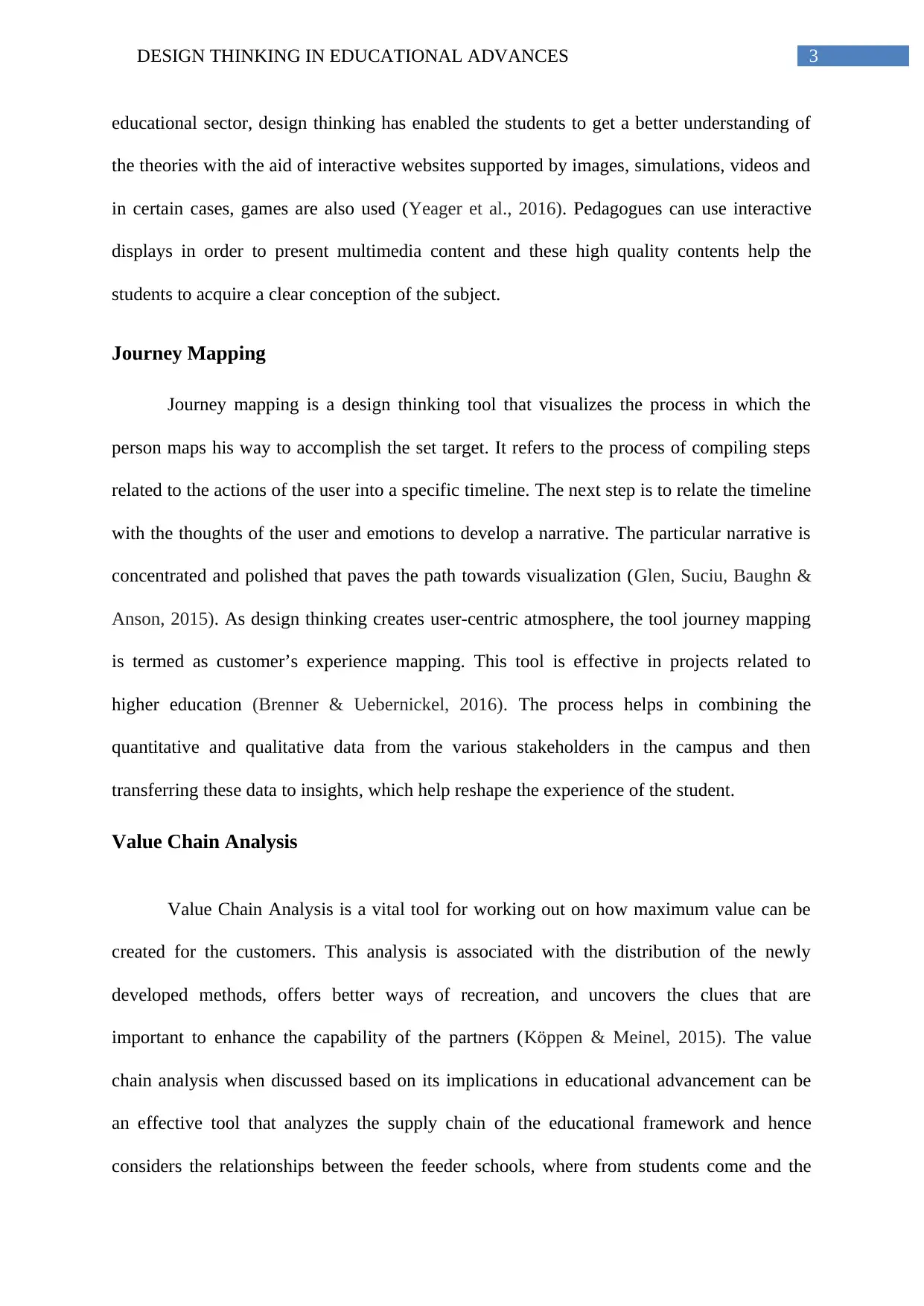
3DESIGN THINKING IN EDUCATIONAL ADVANCES
educational sector, design thinking has enabled the students to get a better understanding of
the theories with the aid of interactive websites supported by images, simulations, videos and
in certain cases, games are also used (Yeager et al., 2016). Pedagogues can use interactive
displays in order to present multimedia content and these high quality contents help the
students to acquire a clear conception of the subject.
Journey Mapping
Journey mapping is a design thinking tool that visualizes the process in which the
person maps his way to accomplish the set target. It refers to the process of compiling steps
related to the actions of the user into a specific timeline. The next step is to relate the timeline
with the thoughts of the user and emotions to develop a narrative. The particular narrative is
concentrated and polished that paves the path towards visualization (Glen, Suciu, Baughn &
Anson, 2015). As design thinking creates user-centric atmosphere, the tool journey mapping
is termed as customer’s experience mapping. This tool is effective in projects related to
higher education (Brenner & Uebernickel, 2016). The process helps in combining the
quantitative and qualitative data from the various stakeholders in the campus and then
transferring these data to insights, which help reshape the experience of the student.
Value Chain Analysis
Value Chain Analysis is a vital tool for working out on how maximum value can be
created for the customers. This analysis is associated with the distribution of the newly
developed methods, offers better ways of recreation, and uncovers the clues that are
important to enhance the capability of the partners (Köppen & Meinel, 2015). The value
chain analysis when discussed based on its implications in educational advancement can be
an effective tool that analyzes the supply chain of the educational framework and hence
considers the relationships between the feeder schools, where from students come and the
educational sector, design thinking has enabled the students to get a better understanding of
the theories with the aid of interactive websites supported by images, simulations, videos and
in certain cases, games are also used (Yeager et al., 2016). Pedagogues can use interactive
displays in order to present multimedia content and these high quality contents help the
students to acquire a clear conception of the subject.
Journey Mapping
Journey mapping is a design thinking tool that visualizes the process in which the
person maps his way to accomplish the set target. It refers to the process of compiling steps
related to the actions of the user into a specific timeline. The next step is to relate the timeline
with the thoughts of the user and emotions to develop a narrative. The particular narrative is
concentrated and polished that paves the path towards visualization (Glen, Suciu, Baughn &
Anson, 2015). As design thinking creates user-centric atmosphere, the tool journey mapping
is termed as customer’s experience mapping. This tool is effective in projects related to
higher education (Brenner & Uebernickel, 2016). The process helps in combining the
quantitative and qualitative data from the various stakeholders in the campus and then
transferring these data to insights, which help reshape the experience of the student.
Value Chain Analysis
Value Chain Analysis is a vital tool for working out on how maximum value can be
created for the customers. This analysis is associated with the distribution of the newly
developed methods, offers better ways of recreation, and uncovers the clues that are
important to enhance the capability of the partners (Köppen & Meinel, 2015). The value
chain analysis when discussed based on its implications in educational advancement can be
an effective tool that analyzes the supply chain of the educational framework and hence
considers the relationships between the feeder schools, where from students come and the
Secure Best Marks with AI Grader
Need help grading? Try our AI Grader for instant feedback on your assignments.
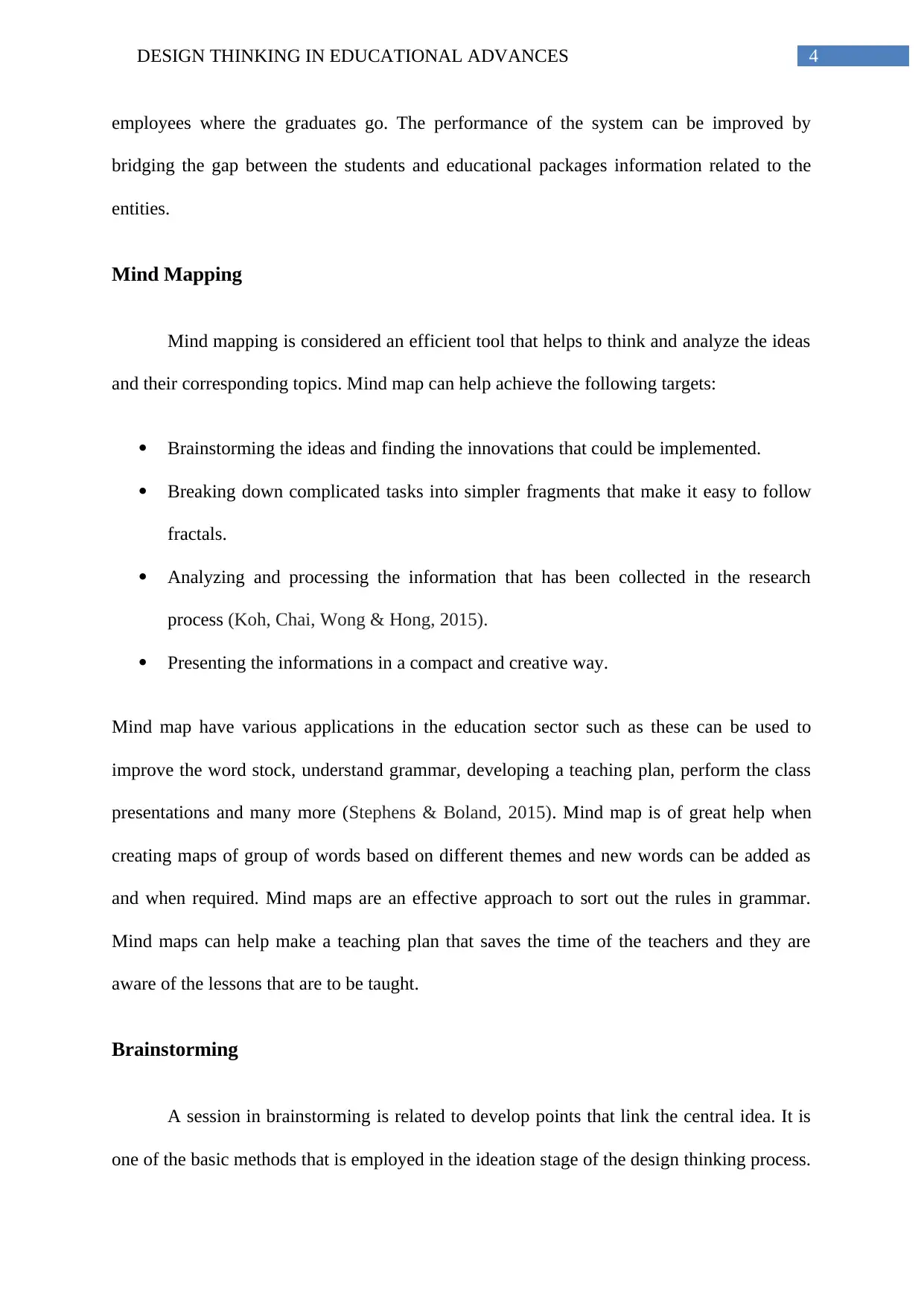
4DESIGN THINKING IN EDUCATIONAL ADVANCES
employees where the graduates go. The performance of the system can be improved by
bridging the gap between the students and educational packages information related to the
entities.
Mind Mapping
Mind mapping is considered an efficient tool that helps to think and analyze the ideas
and their corresponding topics. Mind map can help achieve the following targets:
Brainstorming the ideas and finding the innovations that could be implemented.
Breaking down complicated tasks into simpler fragments that make it easy to follow
fractals.
Analyzing and processing the information that has been collected in the research
process (Koh, Chai, Wong & Hong, 2015).
Presenting the informations in a compact and creative way.
Mind map have various applications in the education sector such as these can be used to
improve the word stock, understand grammar, developing a teaching plan, perform the class
presentations and many more (Stephens & Boland, 2015). Mind map is of great help when
creating maps of group of words based on different themes and new words can be added as
and when required. Mind maps are an effective approach to sort out the rules in grammar.
Mind maps can help make a teaching plan that saves the time of the teachers and they are
aware of the lessons that are to be taught.
Brainstorming
A session in brainstorming is related to develop points that link the central idea. It is
one of the basic methods that is employed in the ideation stage of the design thinking process.
employees where the graduates go. The performance of the system can be improved by
bridging the gap between the students and educational packages information related to the
entities.
Mind Mapping
Mind mapping is considered an efficient tool that helps to think and analyze the ideas
and their corresponding topics. Mind map can help achieve the following targets:
Brainstorming the ideas and finding the innovations that could be implemented.
Breaking down complicated tasks into simpler fragments that make it easy to follow
fractals.
Analyzing and processing the information that has been collected in the research
process (Koh, Chai, Wong & Hong, 2015).
Presenting the informations in a compact and creative way.
Mind map have various applications in the education sector such as these can be used to
improve the word stock, understand grammar, developing a teaching plan, perform the class
presentations and many more (Stephens & Boland, 2015). Mind map is of great help when
creating maps of group of words based on different themes and new words can be added as
and when required. Mind maps are an effective approach to sort out the rules in grammar.
Mind maps can help make a teaching plan that saves the time of the teachers and they are
aware of the lessons that are to be taught.
Brainstorming
A session in brainstorming is related to develop points that link the central idea. It is
one of the basic methods that is employed in the ideation stage of the design thinking process.
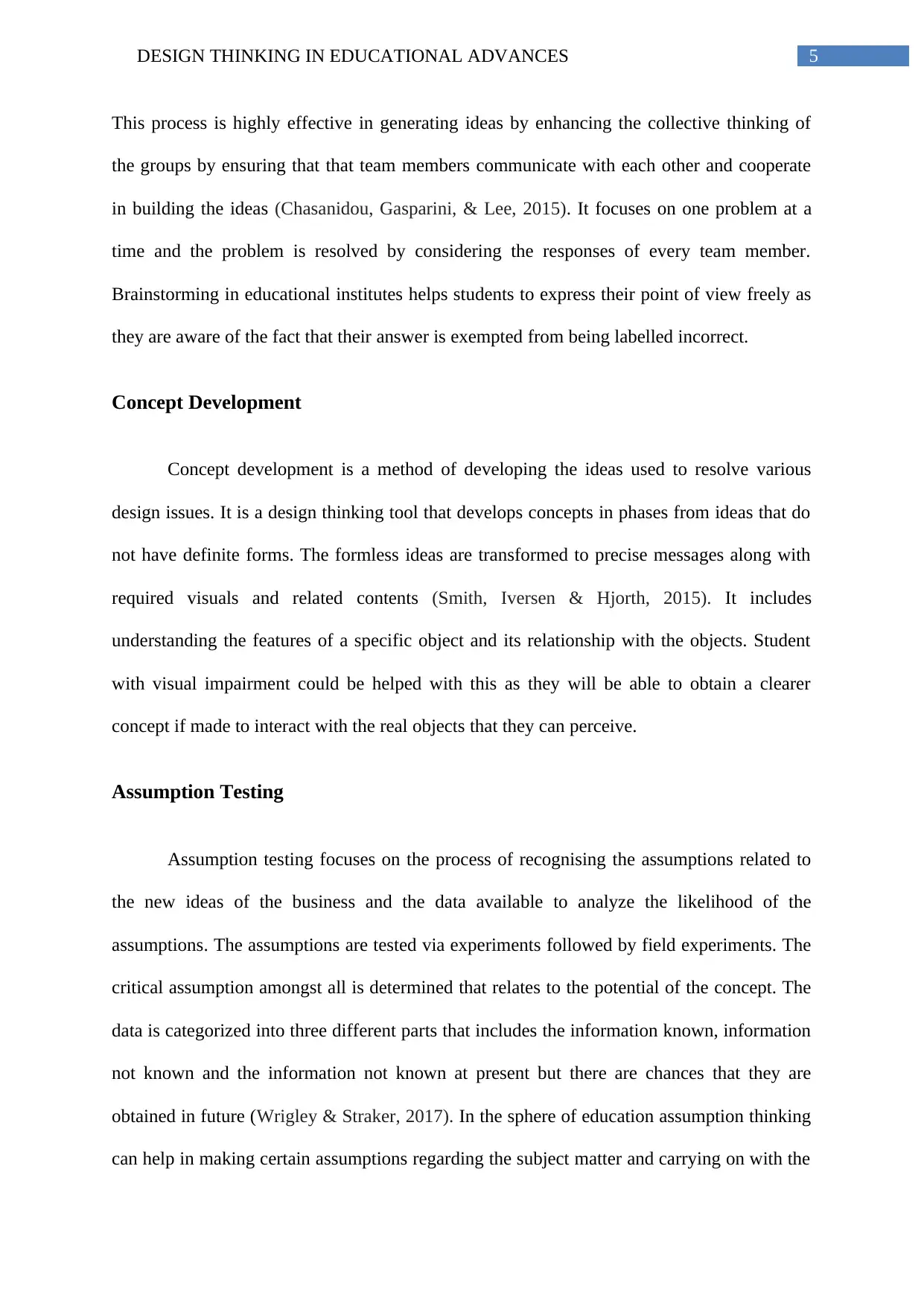
5DESIGN THINKING IN EDUCATIONAL ADVANCES
This process is highly effective in generating ideas by enhancing the collective thinking of
the groups by ensuring that that team members communicate with each other and cooperate
in building the ideas (Chasanidou, Gasparini, & Lee, 2015). It focuses on one problem at a
time and the problem is resolved by considering the responses of every team member.
Brainstorming in educational institutes helps students to express their point of view freely as
they are aware of the fact that their answer is exempted from being labelled incorrect.
Concept Development
Concept development is a method of developing the ideas used to resolve various
design issues. It is a design thinking tool that develops concepts in phases from ideas that do
not have definite forms. The formless ideas are transformed to precise messages along with
required visuals and related contents (Smith, Iversen & Hjorth, 2015). It includes
understanding the features of a specific object and its relationship with the objects. Student
with visual impairment could be helped with this as they will be able to obtain a clearer
concept if made to interact with the real objects that they can perceive.
Assumption Testing
Assumption testing focuses on the process of recognising the assumptions related to
the new ideas of the business and the data available to analyze the likelihood of the
assumptions. The assumptions are tested via experiments followed by field experiments. The
critical assumption amongst all is determined that relates to the potential of the concept. The
data is categorized into three different parts that includes the information known, information
not known and the information not known at present but there are chances that they are
obtained in future (Wrigley & Straker, 2017). In the sphere of education assumption thinking
can help in making certain assumptions regarding the subject matter and carrying on with the
This process is highly effective in generating ideas by enhancing the collective thinking of
the groups by ensuring that that team members communicate with each other and cooperate
in building the ideas (Chasanidou, Gasparini, & Lee, 2015). It focuses on one problem at a
time and the problem is resolved by considering the responses of every team member.
Brainstorming in educational institutes helps students to express their point of view freely as
they are aware of the fact that their answer is exempted from being labelled incorrect.
Concept Development
Concept development is a method of developing the ideas used to resolve various
design issues. It is a design thinking tool that develops concepts in phases from ideas that do
not have definite forms. The formless ideas are transformed to precise messages along with
required visuals and related contents (Smith, Iversen & Hjorth, 2015). It includes
understanding the features of a specific object and its relationship with the objects. Student
with visual impairment could be helped with this as they will be able to obtain a clearer
concept if made to interact with the real objects that they can perceive.
Assumption Testing
Assumption testing focuses on the process of recognising the assumptions related to
the new ideas of the business and the data available to analyze the likelihood of the
assumptions. The assumptions are tested via experiments followed by field experiments. The
critical assumption amongst all is determined that relates to the potential of the concept. The
data is categorized into three different parts that includes the information known, information
not known and the information not known at present but there are chances that they are
obtained in future (Wrigley & Straker, 2017). In the sphere of education assumption thinking
can help in making certain assumptions regarding the subject matter and carrying on with the

6DESIGN THINKING IN EDUCATIONAL ADVANCES
same. The experimental method to test the assumptions helps determine whether it is
applicable to the context or is irrational.
Prototyping
Prototyping is a vital experience user design as it allows testing of ideas and making
relevant improvements on the ideas in a specific time. Prototyping helps in avoiding wastage
of resources by supplying the necessary tools and appropriate approaches for testing and
exploring the ideas properly. A prototype is generally a experimental model related to a
solution that has been proposed to be used to validate ideas and design assumptions along
with the various other aspects of the way it is conceptualized. This helps in bringing possible
transformations in the designs. Prototyping provides alternate solutions for the problems and
is a helpful tool for the students (Martin, 2015). Using prototypes to sell new ideas, motivate
buy-in from internal or external stakeholders, or inspire markets toward radical new ways of
thinking and doing. Prototypes can be used to explore opportunities within the arena of focus
and scrutinize the impact of radical changes. The use of prototypes can help in better
understanding the dynamics of product, system and problem by engaging in physical means.
Customer Co-creation
This tool deals with the technique incorporation that is associated with permitting the
managers to get engaged with the clients during the generation of a format or to develop a
new business policy that includes multiple interests. It is effective in reducing risks and
enhancing growth and innovation. Some parts of the tasks left undone elicit creativity and
evolves competition among the users. It provides the customers with various options that help
them to choose the most appropriate one (Mentzer, Becker & Sutton, 2015). Co-creation of
values is the process of obtaining students’ feedback and various other resources like
institutional resources, intellectual capabilities that holds mutual value for both students and
same. The experimental method to test the assumptions helps determine whether it is
applicable to the context or is irrational.
Prototyping
Prototyping is a vital experience user design as it allows testing of ideas and making
relevant improvements on the ideas in a specific time. Prototyping helps in avoiding wastage
of resources by supplying the necessary tools and appropriate approaches for testing and
exploring the ideas properly. A prototype is generally a experimental model related to a
solution that has been proposed to be used to validate ideas and design assumptions along
with the various other aspects of the way it is conceptualized. This helps in bringing possible
transformations in the designs. Prototyping provides alternate solutions for the problems and
is a helpful tool for the students (Martin, 2015). Using prototypes to sell new ideas, motivate
buy-in from internal or external stakeholders, or inspire markets toward radical new ways of
thinking and doing. Prototypes can be used to explore opportunities within the arena of focus
and scrutinize the impact of radical changes. The use of prototypes can help in better
understanding the dynamics of product, system and problem by engaging in physical means.
Customer Co-creation
This tool deals with the technique incorporation that is associated with permitting the
managers to get engaged with the clients during the generation of a format or to develop a
new business policy that includes multiple interests. It is effective in reducing risks and
enhancing growth and innovation. Some parts of the tasks left undone elicit creativity and
evolves competition among the users. It provides the customers with various options that help
them to choose the most appropriate one (Mentzer, Becker & Sutton, 2015). Co-creation of
values is the process of obtaining students’ feedback and various other resources like
institutional resources, intellectual capabilities that holds mutual value for both students and
Paraphrase This Document
Need a fresh take? Get an instant paraphrase of this document with our AI Paraphraser
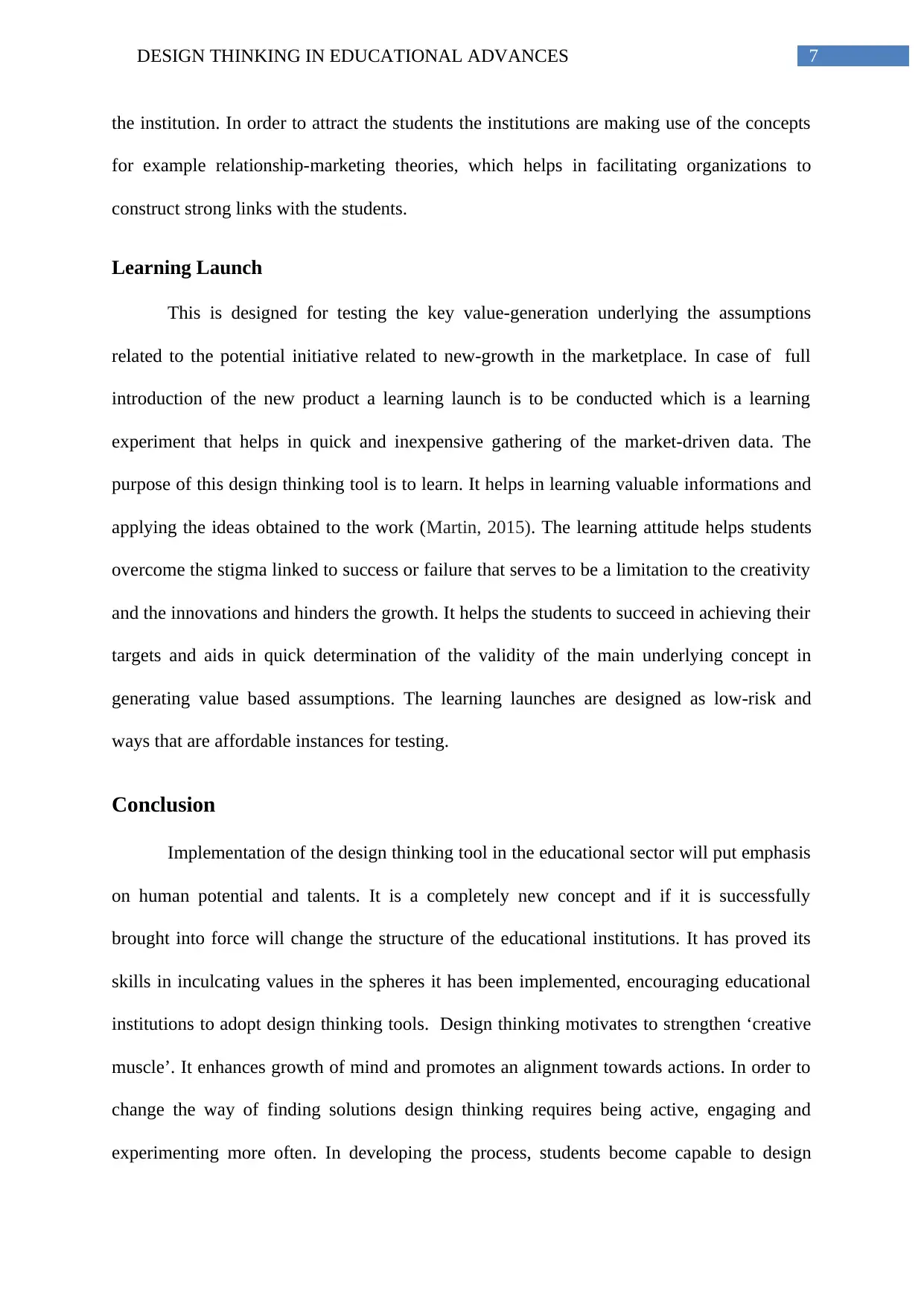
7DESIGN THINKING IN EDUCATIONAL ADVANCES
the institution. In order to attract the students the institutions are making use of the concepts
for example relationship-marketing theories, which helps in facilitating organizations to
construct strong links with the students.
Learning Launch
This is designed for testing the key value-generation underlying the assumptions
related to the potential initiative related to new-growth in the marketplace. In case of full
introduction of the new product a learning launch is to be conducted which is a learning
experiment that helps in quick and inexpensive gathering of the market-driven data. The
purpose of this design thinking tool is to learn. It helps in learning valuable informations and
applying the ideas obtained to the work (Martin, 2015). The learning attitude helps students
overcome the stigma linked to success or failure that serves to be a limitation to the creativity
and the innovations and hinders the growth. It helps the students to succeed in achieving their
targets and aids in quick determination of the validity of the main underlying concept in
generating value based assumptions. The learning launches are designed as low-risk and
ways that are affordable instances for testing.
Conclusion
Implementation of the design thinking tool in the educational sector will put emphasis
on human potential and talents. It is a completely new concept and if it is successfully
brought into force will change the structure of the educational institutions. It has proved its
skills in inculcating values in the spheres it has been implemented, encouraging educational
institutions to adopt design thinking tools. Design thinking motivates to strengthen ‘creative
muscle’. It enhances growth of mind and promotes an alignment towards actions. In order to
change the way of finding solutions design thinking requires being active, engaging and
experimenting more often. In developing the process, students become capable to design
the institution. In order to attract the students the institutions are making use of the concepts
for example relationship-marketing theories, which helps in facilitating organizations to
construct strong links with the students.
Learning Launch
This is designed for testing the key value-generation underlying the assumptions
related to the potential initiative related to new-growth in the marketplace. In case of full
introduction of the new product a learning launch is to be conducted which is a learning
experiment that helps in quick and inexpensive gathering of the market-driven data. The
purpose of this design thinking tool is to learn. It helps in learning valuable informations and
applying the ideas obtained to the work (Martin, 2015). The learning attitude helps students
overcome the stigma linked to success or failure that serves to be a limitation to the creativity
and the innovations and hinders the growth. It helps the students to succeed in achieving their
targets and aids in quick determination of the validity of the main underlying concept in
generating value based assumptions. The learning launches are designed as low-risk and
ways that are affordable instances for testing.
Conclusion
Implementation of the design thinking tool in the educational sector will put emphasis
on human potential and talents. It is a completely new concept and if it is successfully
brought into force will change the structure of the educational institutions. It has proved its
skills in inculcating values in the spheres it has been implemented, encouraging educational
institutions to adopt design thinking tools. Design thinking motivates to strengthen ‘creative
muscle’. It enhances growth of mind and promotes an alignment towards actions. In order to
change the way of finding solutions design thinking requires being active, engaging and
experimenting more often. In developing the process, students become capable to design
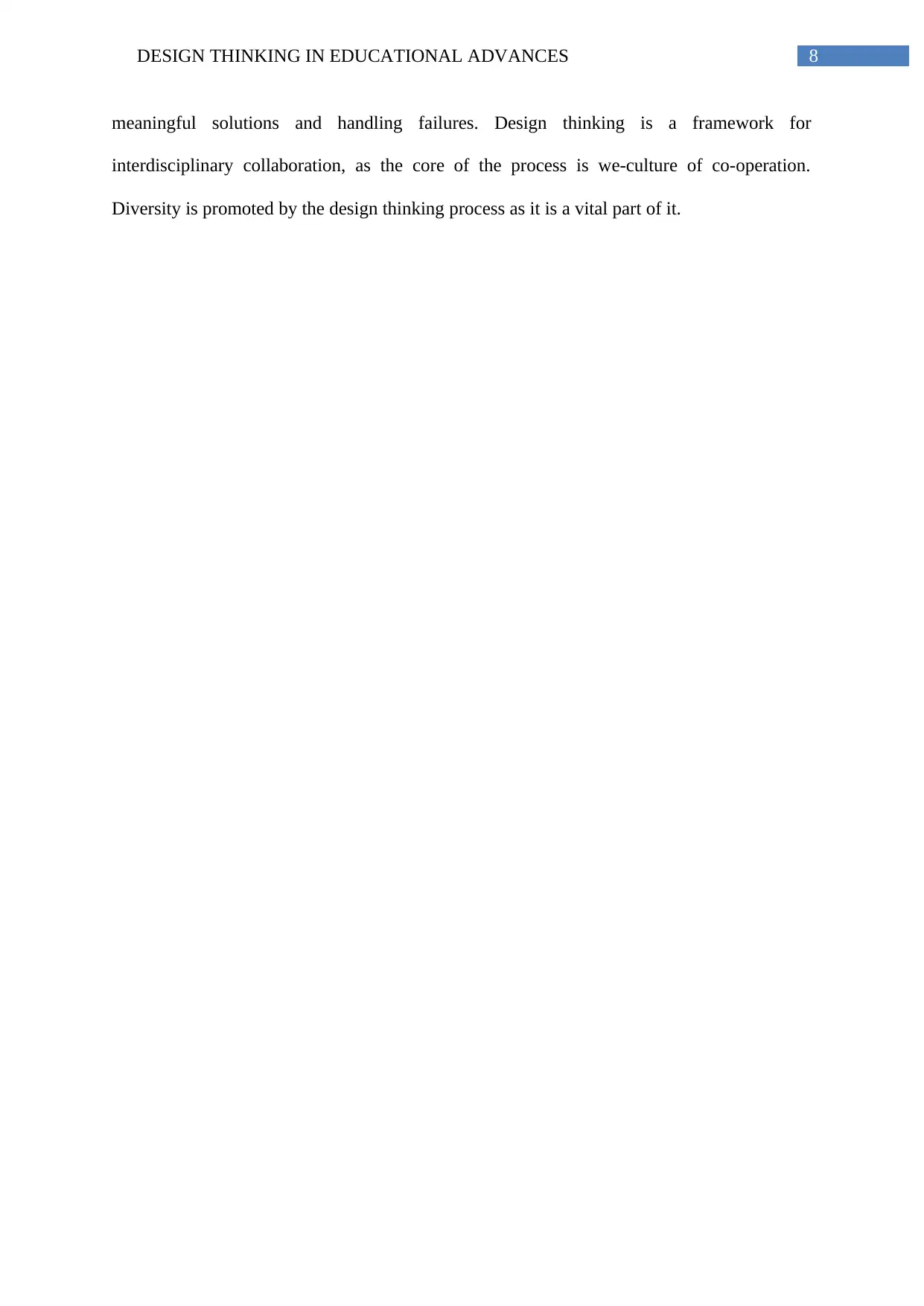
8DESIGN THINKING IN EDUCATIONAL ADVANCES
meaningful solutions and handling failures. Design thinking is a framework for
interdisciplinary collaboration, as the core of the process is we-culture of co-operation.
Diversity is promoted by the design thinking process as it is a vital part of it.
meaningful solutions and handling failures. Design thinking is a framework for
interdisciplinary collaboration, as the core of the process is we-culture of co-operation.
Diversity is promoted by the design thinking process as it is a vital part of it.
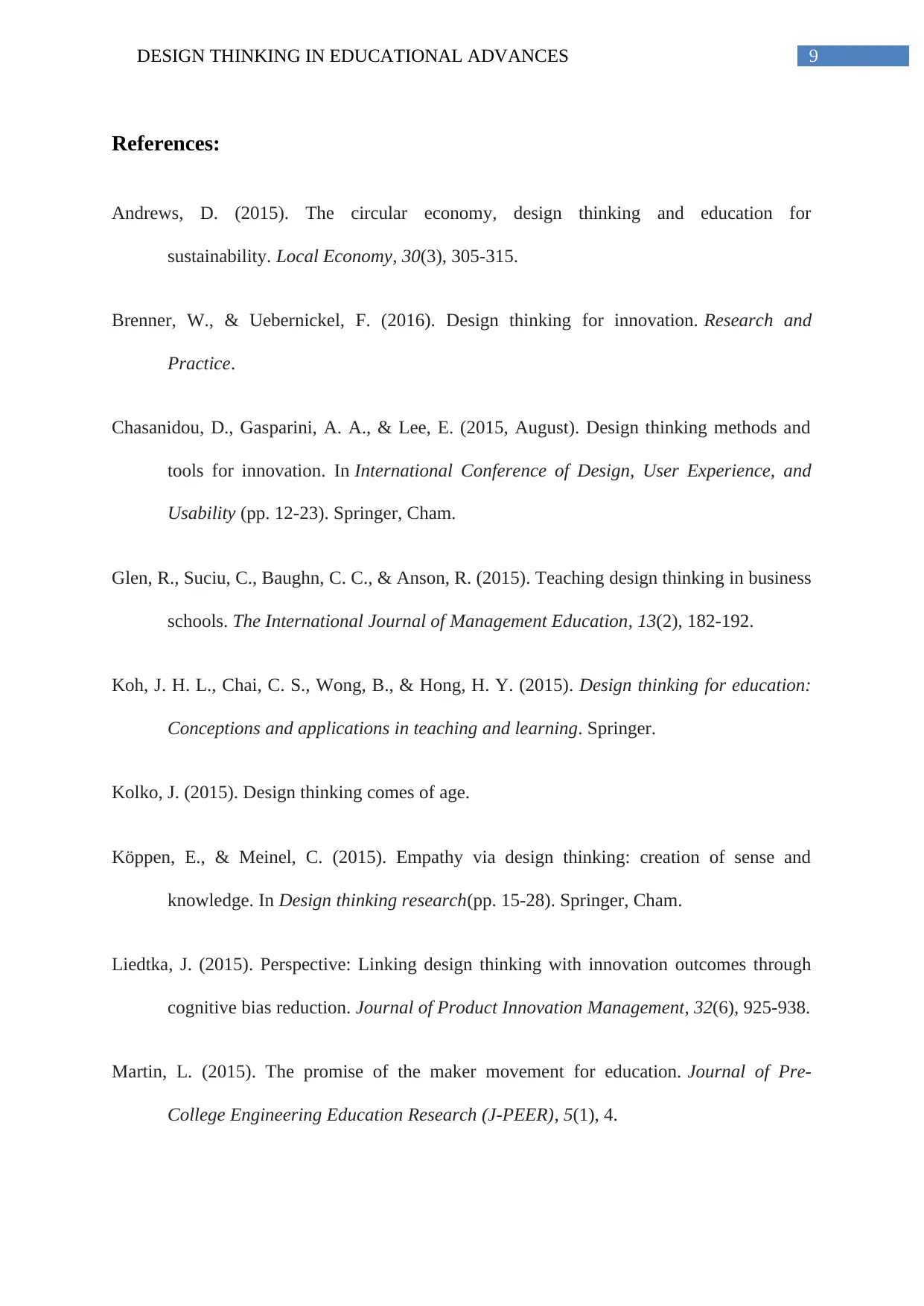
9DESIGN THINKING IN EDUCATIONAL ADVANCES
References:
Andrews, D. (2015). The circular economy, design thinking and education for
sustainability. Local Economy, 30(3), 305-315.
Brenner, W., & Uebernickel, F. (2016). Design thinking for innovation. Research and
Practice.
Chasanidou, D., Gasparini, A. A., & Lee, E. (2015, August). Design thinking methods and
tools for innovation. In International Conference of Design, User Experience, and
Usability (pp. 12-23). Springer, Cham.
Glen, R., Suciu, C., Baughn, C. C., & Anson, R. (2015). Teaching design thinking in business
schools. The International Journal of Management Education, 13(2), 182-192.
Koh, J. H. L., Chai, C. S., Wong, B., & Hong, H. Y. (2015). Design thinking for education:
Conceptions and applications in teaching and learning. Springer.
Kolko, J. (2015). Design thinking comes of age.
Köppen, E., & Meinel, C. (2015). Empathy via design thinking: creation of sense and
knowledge. In Design thinking research(pp. 15-28). Springer, Cham.
Liedtka, J. (2015). Perspective: Linking design thinking with innovation outcomes through
cognitive bias reduction. Journal of Product Innovation Management, 32(6), 925-938.
Martin, L. (2015). The promise of the maker movement for education. Journal of Pre-
College Engineering Education Research (J-PEER), 5(1), 4.
References:
Andrews, D. (2015). The circular economy, design thinking and education for
sustainability. Local Economy, 30(3), 305-315.
Brenner, W., & Uebernickel, F. (2016). Design thinking for innovation. Research and
Practice.
Chasanidou, D., Gasparini, A. A., & Lee, E. (2015, August). Design thinking methods and
tools for innovation. In International Conference of Design, User Experience, and
Usability (pp. 12-23). Springer, Cham.
Glen, R., Suciu, C., Baughn, C. C., & Anson, R. (2015). Teaching design thinking in business
schools. The International Journal of Management Education, 13(2), 182-192.
Koh, J. H. L., Chai, C. S., Wong, B., & Hong, H. Y. (2015). Design thinking for education:
Conceptions and applications in teaching and learning. Springer.
Kolko, J. (2015). Design thinking comes of age.
Köppen, E., & Meinel, C. (2015). Empathy via design thinking: creation of sense and
knowledge. In Design thinking research(pp. 15-28). Springer, Cham.
Liedtka, J. (2015). Perspective: Linking design thinking with innovation outcomes through
cognitive bias reduction. Journal of Product Innovation Management, 32(6), 925-938.
Martin, L. (2015). The promise of the maker movement for education. Journal of Pre-
College Engineering Education Research (J-PEER), 5(1), 4.
Secure Best Marks with AI Grader
Need help grading? Try our AI Grader for instant feedback on your assignments.
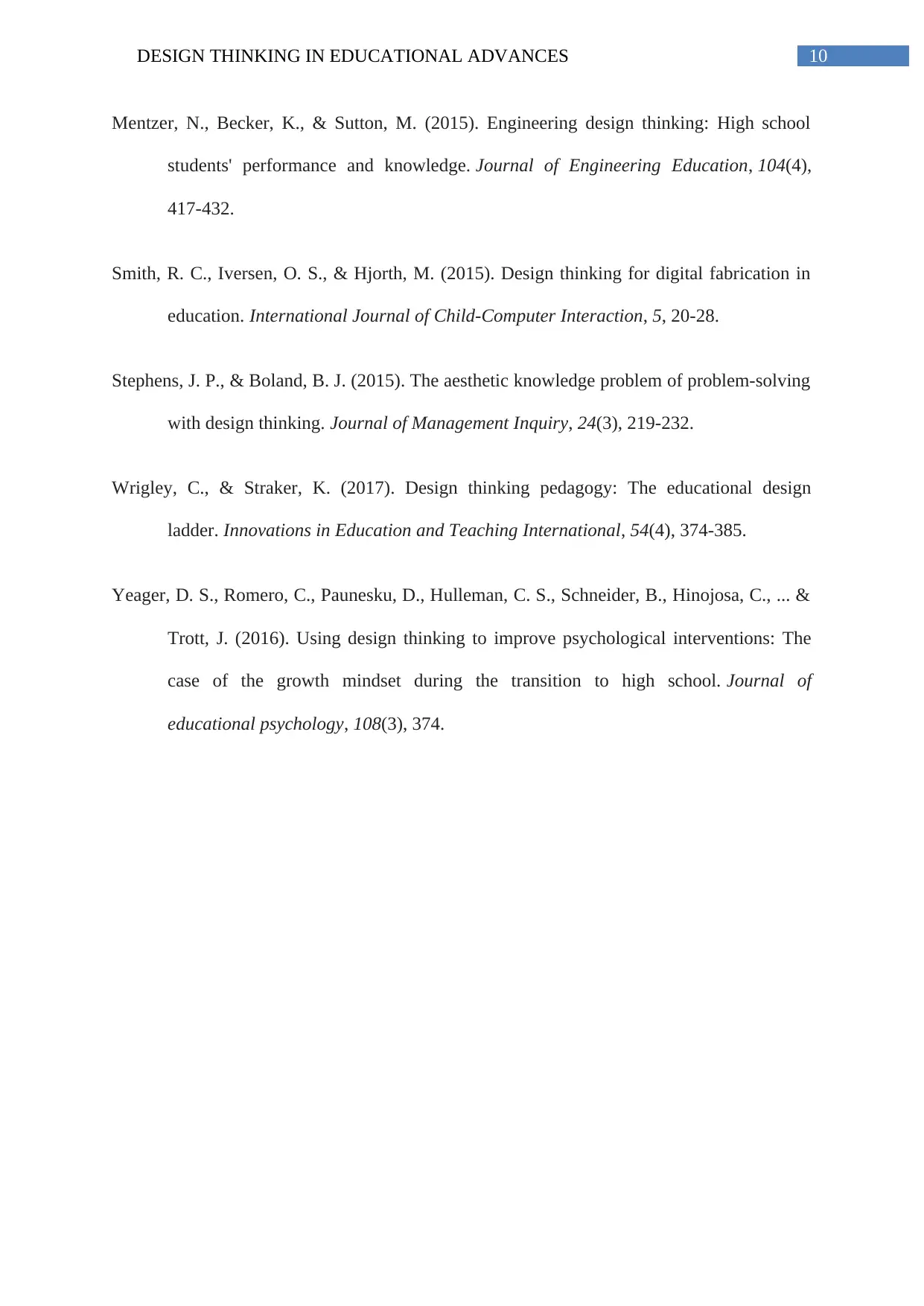
10DESIGN THINKING IN EDUCATIONAL ADVANCES
Mentzer, N., Becker, K., & Sutton, M. (2015). Engineering design thinking: High school
students' performance and knowledge. Journal of Engineering Education, 104(4),
417-432.
Smith, R. C., Iversen, O. S., & Hjorth, M. (2015). Design thinking for digital fabrication in
education. International Journal of Child-Computer Interaction, 5, 20-28.
Stephens, J. P., & Boland, B. J. (2015). The aesthetic knowledge problem of problem-solving
with design thinking. Journal of Management Inquiry, 24(3), 219-232.
Wrigley, C., & Straker, K. (2017). Design thinking pedagogy: The educational design
ladder. Innovations in Education and Teaching International, 54(4), 374-385.
Yeager, D. S., Romero, C., Paunesku, D., Hulleman, C. S., Schneider, B., Hinojosa, C., ... &
Trott, J. (2016). Using design thinking to improve psychological interventions: The
case of the growth mindset during the transition to high school. Journal of
educational psychology, 108(3), 374.
Mentzer, N., Becker, K., & Sutton, M. (2015). Engineering design thinking: High school
students' performance and knowledge. Journal of Engineering Education, 104(4),
417-432.
Smith, R. C., Iversen, O. S., & Hjorth, M. (2015). Design thinking for digital fabrication in
education. International Journal of Child-Computer Interaction, 5, 20-28.
Stephens, J. P., & Boland, B. J. (2015). The aesthetic knowledge problem of problem-solving
with design thinking. Journal of Management Inquiry, 24(3), 219-232.
Wrigley, C., & Straker, K. (2017). Design thinking pedagogy: The educational design
ladder. Innovations in Education and Teaching International, 54(4), 374-385.
Yeager, D. S., Romero, C., Paunesku, D., Hulleman, C. S., Schneider, B., Hinojosa, C., ... &
Trott, J. (2016). Using design thinking to improve psychological interventions: The
case of the growth mindset during the transition to high school. Journal of
educational psychology, 108(3), 374.
1 out of 11
Related Documents
Your All-in-One AI-Powered Toolkit for Academic Success.
+13062052269
info@desklib.com
Available 24*7 on WhatsApp / Email
![[object Object]](/_next/static/media/star-bottom.7253800d.svg)
Unlock your academic potential
© 2024 | Zucol Services PVT LTD | All rights reserved.




